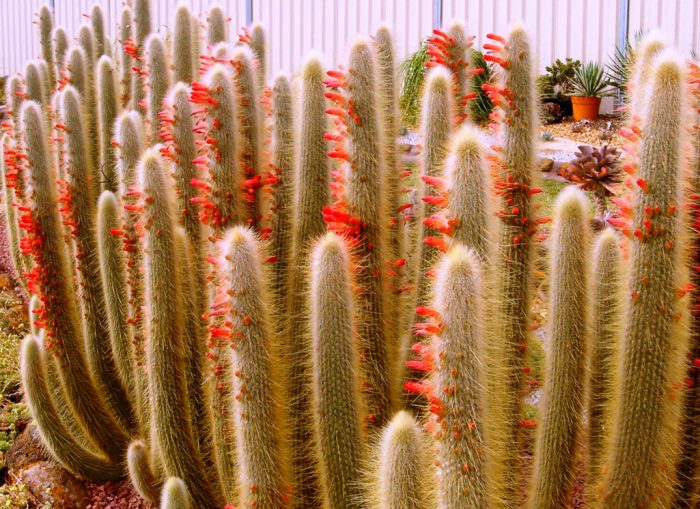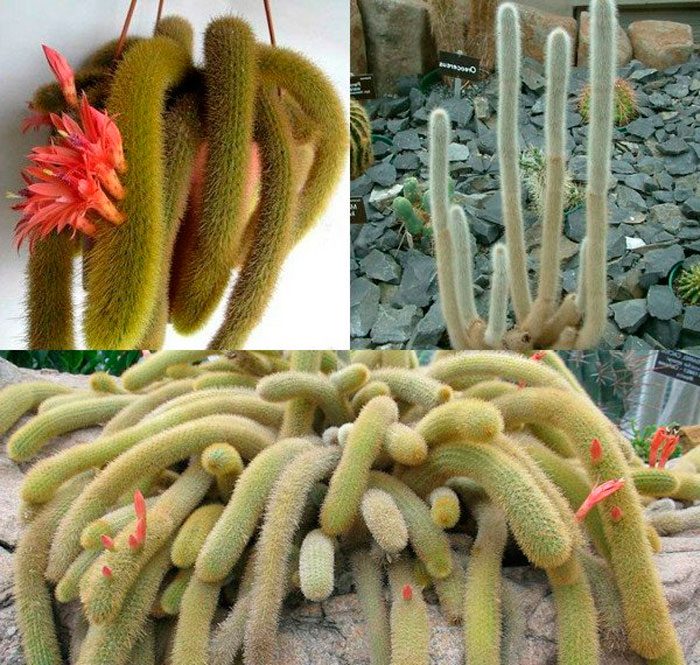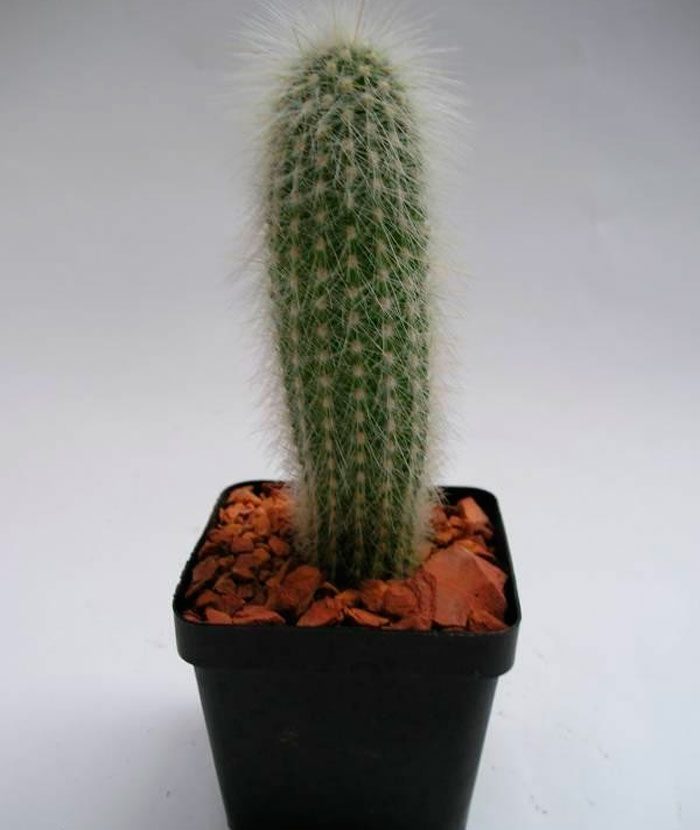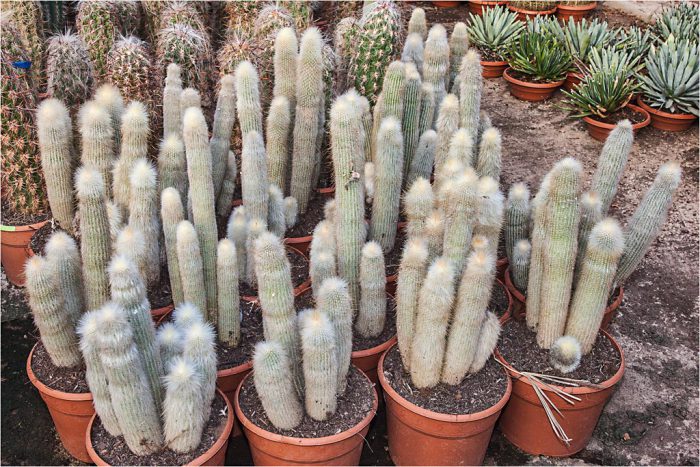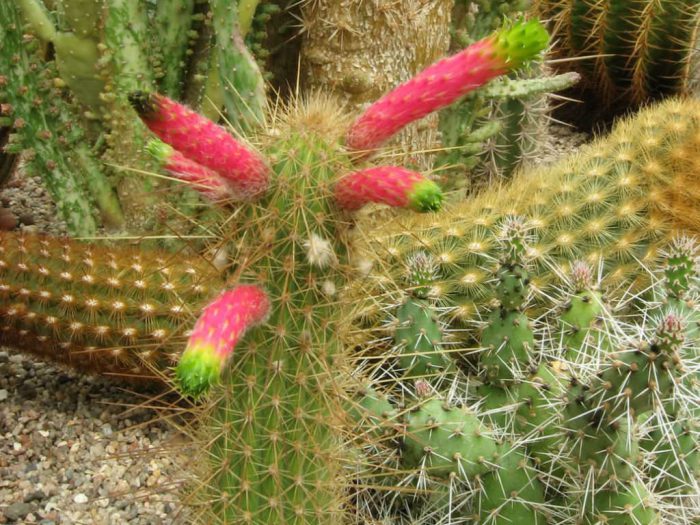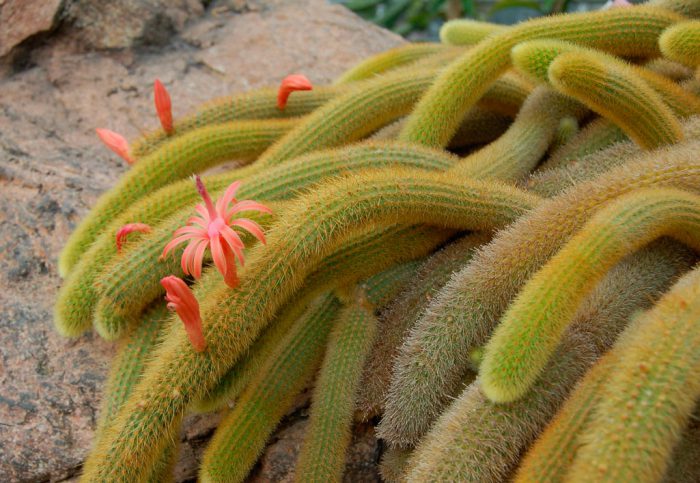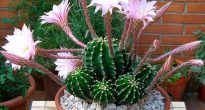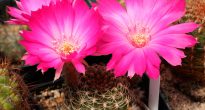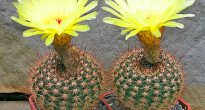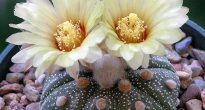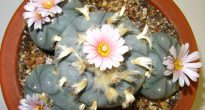Kind of like cleistocactus (Cleistocactus) unites about 50 different plant species. In nature, they can be found in South America, and mostly in Uruguay. This genus of cacti can be easily distinguished by columnar rather thin shoots that branch at the base. On the surface of these stems there is a huge number of areoles, so the cactus itself is densely covered with white-yellow spines.
You can also distinguish this type of cactus by its rather unusual flowers. On the surface of the tubular flower, there are many scales. However, these flowers do not open in a large number of cacti, and this phenomenon is called cleistogamy (which served as the formation of the genus name). Over time, the bud becomes similar to a fairly long, brightly colored bud. Seeds are formed inside such a flower as a result of self-pollination.
Cleistocactus care at home
These plants are rather unpretentious and not capricious. However, in order for them to grow and develop normally, it is necessary to adhere to certain rules in care.
Illumination
He is very fond of light and needs direct sunlight throughout the year. It is recommended to select a south-facing window to place it.
Temperature regime
It is recommended to grow this plant in the warm season at an air temperature of 22 to 26 degrees. In winter, there is a dormant period. Therefore, cleistocactus for this time should be placed in a fairly cool place (about 10-12 degrees).
How to water
The amount of watering depends on the season and the state of the potted substrate. So, watering is recommended only after the soil is completely dry. In summer, during hot months, the soil dries out much faster, so watering at this time will be more abundant than in the autumn-winter period.
With the onset of winter, the plant is rarely watered, in order to avoid the development of rot due to the soil that does not dry out for a long time.
For irrigation, it is necessary to use settled water at room temperature, which does not contain lime.
Humidity
Feels great in moderate humidity. On hot summer days, when the humidity is too low, it is recommended to regularly moisten the cactus from a sprayer.
Earth mixture
For this plant, neutral loose soil is suitable, which is good for air and water.You can buy a special ready-made mixture for cacti in the store. You can also make a soil mixture with your own hands by combining sod, leafy and peat soil, and also coarse river sand, which should be taken in a ratio of 2: 2: 1: 4.
Do not forget to make a good drainage layer at the bottom of the pot, which can prevent stagnation of moisture in the soil, using broken shards or expanded clay for this.
Top dressing
It is fed during the period of intensive growth once every 7 days. For this, fertilizers are used for cacti. In winter, fertilizers are not applied to the soil.
Transplant features
Young plants are transplanted once a year, and it is recommended to do this in the spring. Adult specimens are transplanted only when necessary, for example, when the roots no longer fit in the pot.
Reproduction methods
You can propagate it by “kids” and seeds.
Sowing seeds can be done at any time of the year, while you must follow the instructions on the packaging or found in special literature.
For reproduction by "children" you need to carefully separate the stalk from the mother plant and leave it in the open air for a week (in order for it to dry out). Then it should be planted in a pot filled with an earth mixture suitable for cleistocactus. To begin with, the young plant should be strengthened by tying it to a support for this.
Diseases and pests
This plant can settle spider mite or mealybug... If they are found, treatment with appropriate drugs should be carried out.
A variety of rots can appear on the plant, which are formed as a result of improper care.
Main types
Each species has its own distinctive features. So, according to the nature of growth, these plants are divided into horizontal, columnar and creeping.
Strauss' Cleistocactus (Cleistocactus strausii)
It is considered the most striking example of a columnar cactus. This cactus has greenish-gray erect shoots that are vertical. They can grow up to 3 meters in height, while their diameter is only 15 centimeters. There are 20–30 ribs on which there are many small whitish areoles, very closely spaced (0.5 centimeters apart). A bunch of bristle-shaped yellow spines emerge from each areola, which may make the shoot appear to be covered with thick wool. At the same time, there are 4 long and thick central spines, reaching 4 centimeters in length, and about 30 pieces - thin short radial ones. This species produces a lot of flowers that are colored red. They are closed, while the length of the tube is approximately 6 centimeters. The cactus blooms in the last summer weeks, with a flowering duration of 4 weeks. Only those specimens bloom that reach at least 45 centimeters in height.
This species has a very spectacular and unusual scallop shape.
Emerald-flowered cleistocactus (Cleistocactus smaragdiflorus)
A striking representative of horizontal cacti is emerald-flowered cleistocactus. Its dark green shoots branch strongly at the base. In adult specimens, they can grow up to 100 centimeters in length, while their diameter is only 3 centimeters. Each shoot has from 12 to 14 ribs, on which there are many areoles, tightly pressed against each other. A bunch of powerful spiny needles emerges from each areola, of which there are from 10 to 30 pieces. At the same time, the length of the central spine is 5 centimeters, and the radial one is 1 centimeter. Formed reddish-pink closed (non-opening) flowers with a greenish top. The tube is about 5 centimeters long. Cacti bloom, the height of which is 30 centimeters or more.
Winter's Cleistocactus (Cleistocactus winteri)
It is the most popular of the creeping cactus group. Hanging green shoots can be up to 100 centimeters long, while their diameter is only 2.5 centimeters.On their surface is a huge number of corymbose yellow-golden spines. Central needles do not differ from radial needles. During flowering, unfolding multi-petal flowers appear, painted in a pinkish-orange color. The length of the tube reaches about 6 centimeters.

